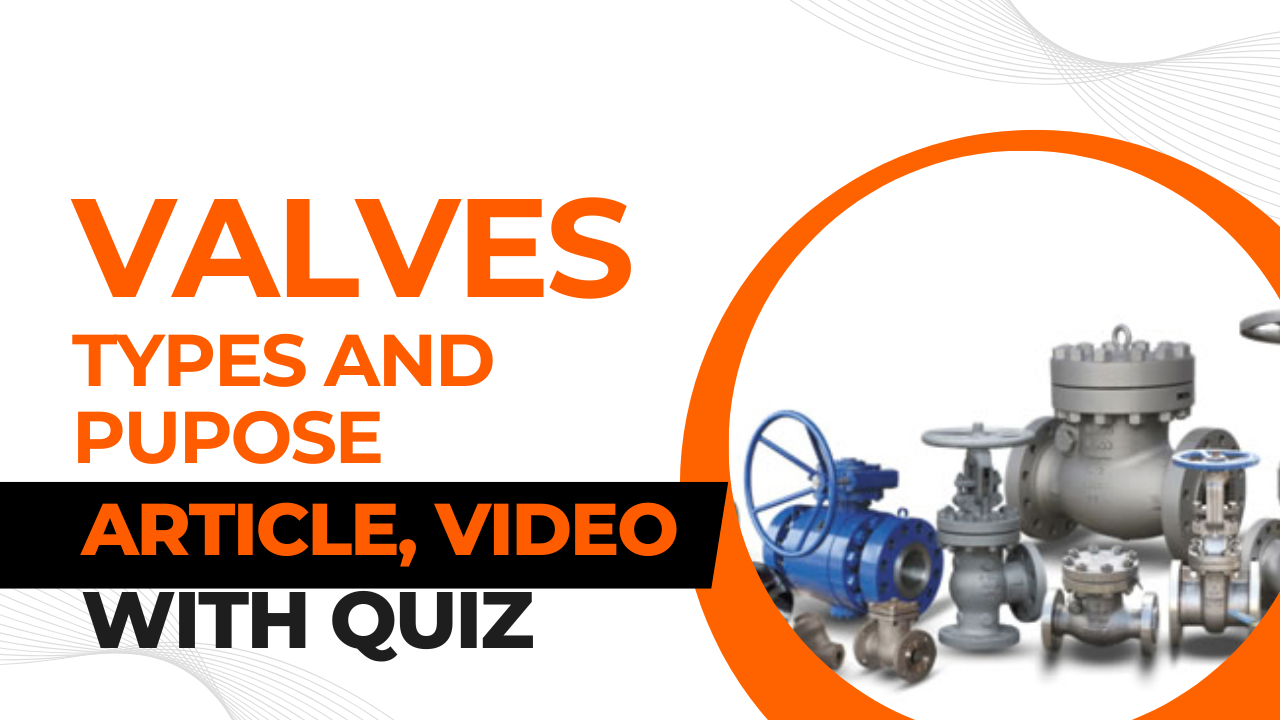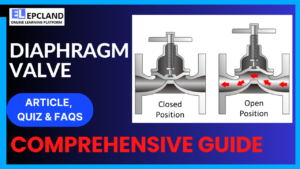Valves play a pivotal role in piping systems, controlling the flow of fluids and gases while ensuring safe and efficient operation. This comprehensive guide explores the various types of valves, their purposes, and the factors to consider when selecting the right valve for a specific application.
Table of Contents
Understanding Valves in Piping Systems
Valves are mechanical devices designed to regulate, control, and direct the flow of fluids, gases, and slurries within a piping system. They serve as crucial components in various industries, including oil and gas, petrochemicals, water treatment, and more.
Don’t miss the Complete Course on Piping Engineering: Check Now
By EPCLand.com
Types of Valves
There is a wide range of valve types, each tailored to specific applications and operational requirements:
1. Gate Valves
- Designed for on/off control.
- Operates by raising or lowering a gate to obstruct or permit flow.
- Commonly used in systems where minimal pressure drop is essential.
2. Globe Valves
- Provides precise control of fluid flow.
- Uses a plug that moves against or away from the flow to regulate passage.
- Suitable for applications requiring accurate throttling.
3. Ball Valves
- Features a spherical disc to control flow.
- Offers quick and reliable shut-off capabilities.
- Well-suited for high-pressure applications.
4. Butterfly Valves
- Uses a rotating disc to control flow.
- Ideal for large-volume applications due to its simple design.
- Provides quick shut-off and minimal pressure drop.
5. Check Valves
- Designed to prevent backflow.
- Allows fluid or gas to flow in only one direction.
- Ensures system integrity and prevents damage.
Purpose of Valves
Valves serve several critical purposes within piping systems:
- Flow Regulation: Valves control the rate of fluid or gas flow, optimizing process efficiency.
- Isolation: Valves isolate sections of a system for maintenance or repairs.
- Backflow Prevention: Check valves prevent reverse flow, maintaining system integrity.
- Pressure Regulation: Valves regulate pressure to prevent overloading downstream equipment.
- Safety Shutdown: Valves can quickly shut down flow in emergencies to prevent accidents.
Selecting the Right Valve for the Job
Choosing the appropriate valve involves considering various factors, including:
1. Fluid Characteristics
Different fluids have varying viscosity, corrosiveness, and temperature requirements. Select a valve material and design suitable for the fluid’s properties.
2. Pressure and Temperature
Valves must handle the system’s pressure and temperature conditions without failure. Ensure the selected valve has the appropriate pressure and temperature ratings.
3. Flow Control Requirements
Determine whether precise throttling or simple on/off control is necessary for your application. Choose a valve type that meets these requirements.
4. Pipe Size and Compatibility
Select a valve size compatible with the piping system and connections. Ensure flange or thread specifications match.
5. Environmental Considerations
Consider factors like potential exposure to corrosive substances, outdoor conditions, or hazardous environments when choosing valve materials.
FAQs (Frequently Asked Questions)
Q1: What is the purpose of a check valve? A1: Check valves prevent backflow, maintaining system integrity and preventing damage.
Q2: Which valve type is suitable for precise flow control? A2: Globe valves are designed for accurate throttling and precise control of fluid flow.
Q3: What is the key consideration when selecting a valve? A3: Fluid characteristics, pressure and temperature requirements, and flow control needs are crucial factors.
Q4: How do ball valves differ from gate valves? A4: Ball valves use a spherical disc for flow control, while gate valves use a gate that rises or lowers.
Q5: Are butterfly valves suitable for high-pressure applications? A5: Yes, butterfly valves are well-suited for high-pressure applications due to their reliable shut-off capabilities.
Conclusion
Valves are the unsung heroes of piping systems, enabling efficient and controlled fluid and gas transport. Understanding the types of valves available and their purposes is essential for selecting the right valve for any application. By considering factors like fluid characteristics, pressure, temperature, and flow control needs, engineers can ensure safe, reliable, and optimized operations in various industries. The careful selection of valves contributes to the longevity and effectiveness of piping systems, making them a cornerstone of piping engineering.
Recommended courses (Published on EPCLand)
- Basics of Piping Engineering
- Piping Layout Engineering
- Piping Material Engineering
- Piping Stress Analysis
- Complete Course on Piping Engineering
- Material Requisitions
- Piping Material Specifications
- Valve Material Specifications
Don’t miss the published articles on following:
Related Video
Attempt Quiz
Question 1:
What is the primary purpose of valves in piping systems?
Explanation: The primary purpose of valves in piping systems is to regulate fluid flow, control pressure, and direct the movement of fluids within a system.
Question 2:
Which type of valve is commonly used to stop or start fluid flow in a pipeline?
Explanation: Globe valves are commonly used to start or stop fluid flow by moving a disc against the flow, controlling the opening and closing of the valve.
Question 3:
Which type of valve allows fluid to flow in one direction and prevents backflow?
Explanation: Check valves are designed to allow fluid flow in one direction and prevent backflow, ensuring that fluids move in the intended direction within the pipeline.
Question 4:
Which factor is NOT typically considered when selecting a valve for a specific application?
Explanation: Valve color is not typically considered when selecting a valve for a specific application. Factors such as pressure rating, temperature range, and flow rate are important considerations.
Question 5:
Which type of valve provides precise control over fluid flow by using a circular plate or disc?
Explanation: Control valves are designed to provide precise control over fluid flow by using a circular plate or disc that can be positioned to regulate the flow rate based on the desired setpoint.



